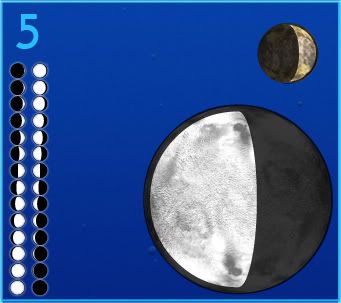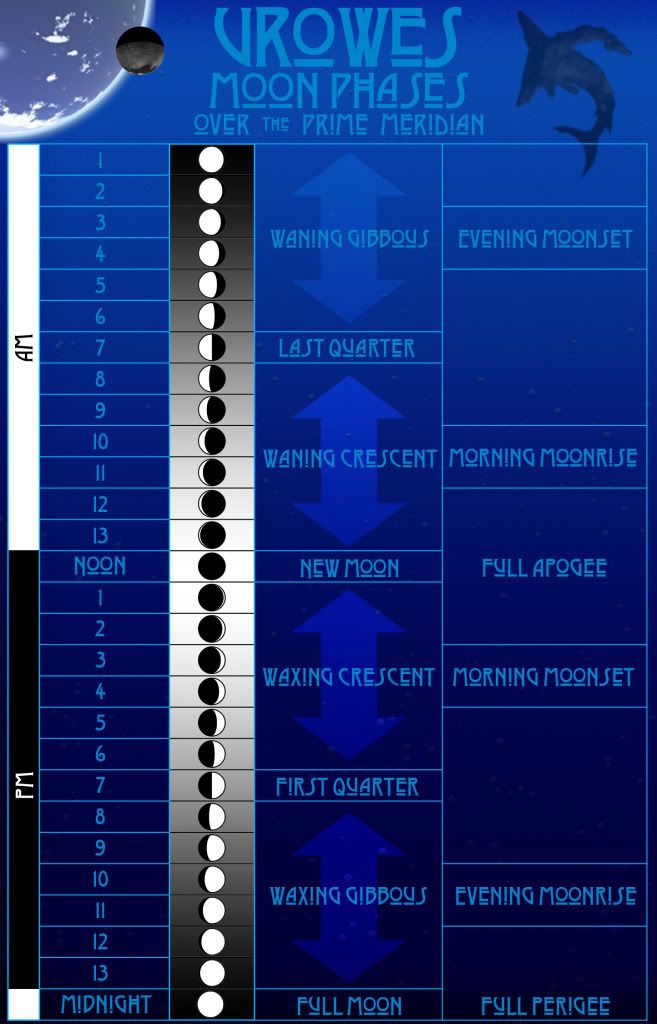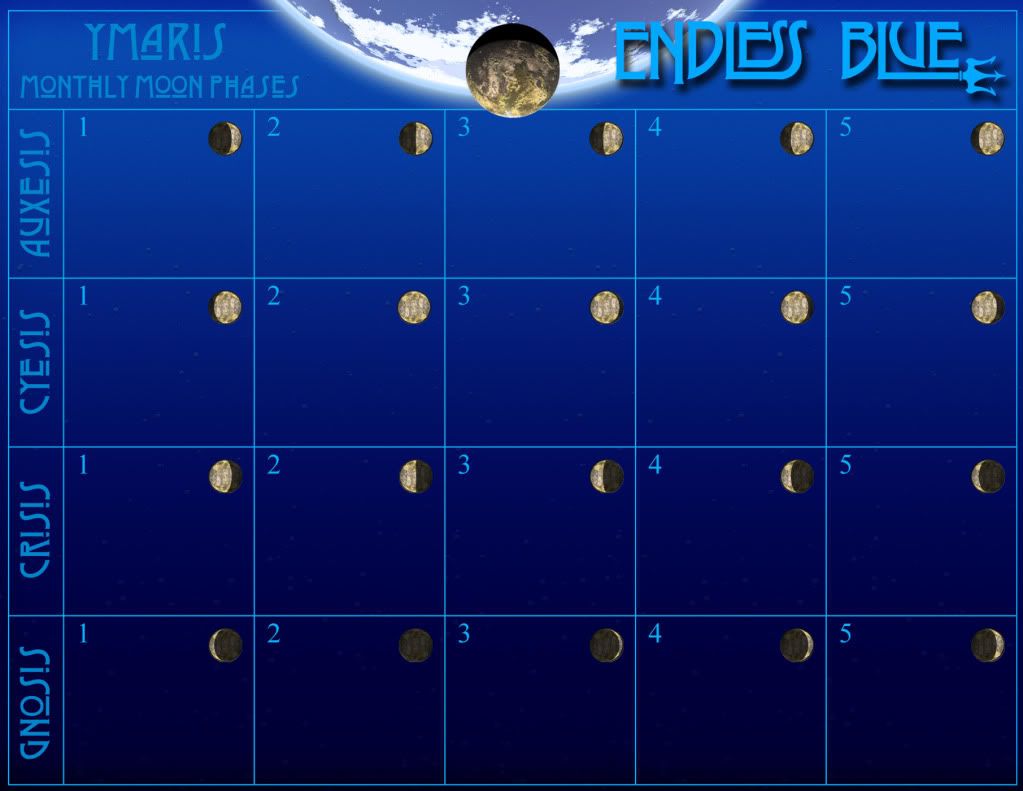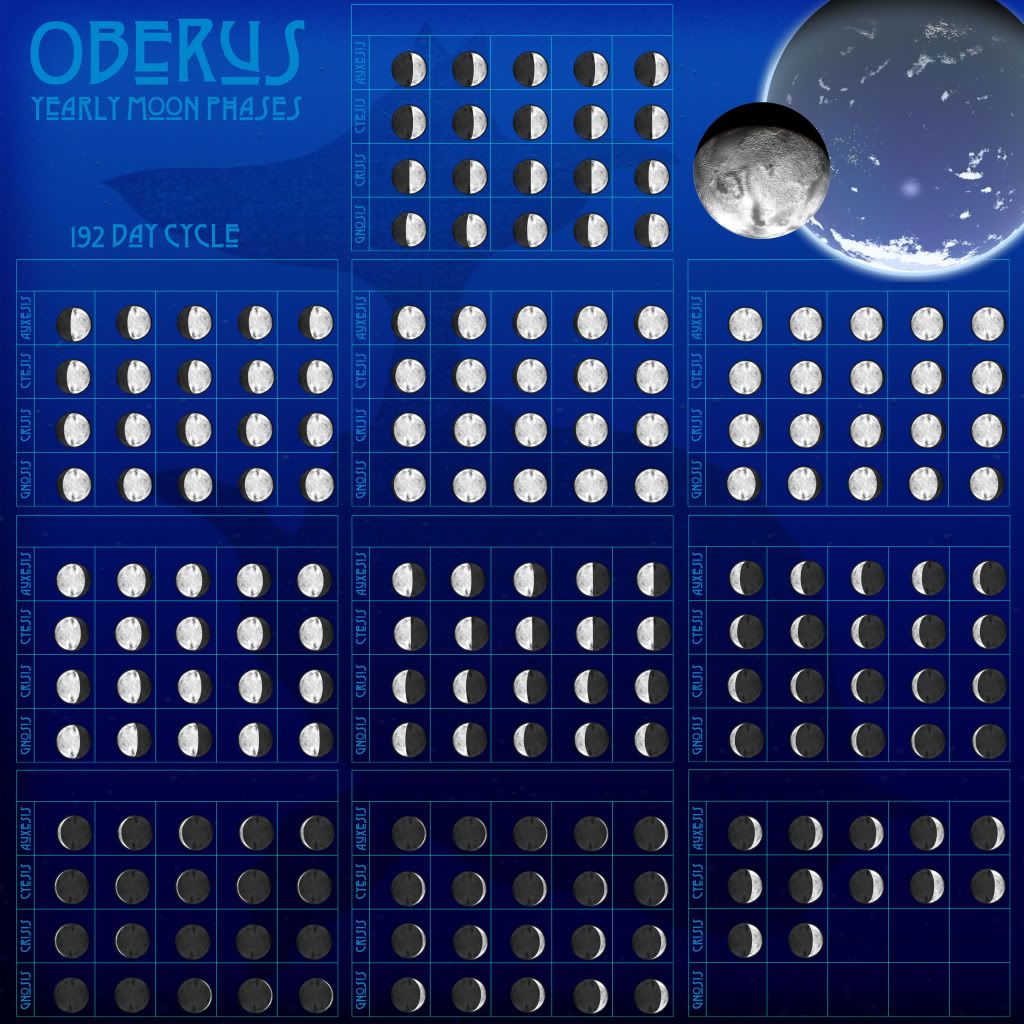Chronology
The Elquan AgesThe history of Elqua is divided into a spectrum of various Epochs. There is no set length for an epoch; instead the names are given to periods of history that share a common essence, a theme. For example, the White is so called due to it being the beginning of the world, just as light is the beginning of color. The metaphysical egg known as the Source is attributed to that color and to having been the creation of the world, and at the end of the age the water world of Elqua had become frozen over with ice, also white.
The White
The First Verse is uttered.
The time of the Source and the creation of the world.
Elqua is formed from the firmament.
The White ends with the Ice Age, as it completely encapsulates the planet in a thick layer of impenetrable ice.
The Cardinal Epoch
With the world frozen over, gave rise to the Red (rhodoarchaea).
With the land and sea separated, evolution took them in different directions. The sea gave birth to the sentient races, while aberrations ruled above the waves.
The Piscean Form appears in the oceans of Elqua in an example of convergent evolution, a biological adaption made by at least eight different races. The first of these races to reach dominance is the Icht, and begin to spread their influence throughout the waters of Elqua.
Red tides are rampant, decimating many of the primitive races each time they come close to achieving civilization -- except for the Icht, whom seem to be conspicuously spared the ravages of the blood bloom.
The Bronze Epoch
Height of the Icht Dominion. Very aloof, very removed from the rest of the Known World, with advanced technology significantly greater than their neighors. The collapse of the Icht Dominion appears to have been quick and complete, with little to remain of their existence. Possibly created the Spurs, whose earliest mention came from the same time period.
The ancient cetaceans begin to form tribes.
The Chelon discover the first simple spells of what eventually became Xanthellae.
Records surface of the discover of what will be come known as the first Spur.
The beginning of the Shellback Wars, a recurring skirmish that lasts to this day. On and off throughout history, even during the Kraken Occupation.
The Golden Epoch
Rise of the cetacean barbarians known as the Orcan Hordes. In the chaos of frequent invasion into other territories, a newly isolated Mer current is lost to antiquity.
Showing their own brand of mindless savagery, two Mer Currents bring about each others' assured extinction. In their memory, the document known as the Codex of Piscean Rights is drafted in an attempt to unite the suffering bodies of water into a cohesive collective whole known as the Fluid Nations. Despite the high ideals espoused, the document is given little more than lip service.
Sightings of Kraken fade into myth as the species begins a clandestine base of operations hidden in the Maw. At the same time, the Icht Dominion seems to fade into history with little notice.
The Verdant/Verdigris Epoch
Originally touted as the new Green Age of peace, prosperity, and plenty, with the warring bodies of water reaching a cessation of hostilities. Unfortunately, events unfolded to make this period in Elquan history one of the most tragic and cancerous ever known.
Seamus Lorwinn, future evolutionist, was born in the Mer Currents.
The movement known as the Godless begins. It is a direct reaction to the class warfare between the ruling parties (the various religions) and the working masses. It begins the formation of the middle class.
A series of betrayals among the Fluid Nations, starting with the resumption of the Shellback Wars.
The normally avoided Maw explodes with activity, and the Kraken Occupation begins.
Believed to have made dark pacts with their eldritch gods, the Kraken Empire stretched across more of Elqua than even the Icht. Known for their Behemoths, domesticated gargantuans of the deep. Secret of their enslavement is lost. Either punished for some transgression or simply abandoned, the degeneration of the huge beasts into the Ceph of today over a few millennia is a source of bias that the Kraken still have to endure.
The Kouton some how broker a deal with the Kraken to maintain a façade of independence, while instead becoming Kraken sympathizers.
The Kraken successfully wipe out a Mer Current in a systematic racial clensing what has been dubbed "The Wash".
A ceasation of hostilities orchestrated by the Ocrans that allowed Chelon ultravision magick and Lumulan dearthsteel to be married together and set in motion the end of the Kraken Empire.
The Epoch ends with the fall of the Kraken Empire.
The Cerulean Epoch
The Maw is cordoned off by the Olyhydrans, displacing many Mer and causing another current to become lost. A propagandistic campaign by the church ingrains fear of the area into the populace.
Rise of the Mer Currents as the dominant race. The Narwahl succeed from the Cetacean Oceans and the people relocated in the Sahaguin Lagoons.
The Church of Olyhydra, boosted by popular impression of their efforts during the Occupation, becomes the major religion of the world with alarming speed.
The Kelpygmies begin to appear, scattered throughout the Known World. It is uncertain if the tribes had just now sprouted, or had existed previously but in hiding.
Ongoing border skirmishes with the primitive races that have penned in the before-now expansionistic civilized races. With increases in population and a limited area of water to live in, eyes look to usurping space from the Periphery by faith or by force.
Rumors of Indigo begin to spread in the primitive races and are mostly dismissed by the civilized races as superstitious nonsense.
Anti-Ceph sentiment rises as fear mongers remonstrate the degenerate Kraken do not follow the piscean form, therefore are not to be regarded as equals or afforded those rights.
Today, the current time period of the Endless Blue Campaign Setting.
The Indigo Epoch
It becomes increasingly clear to most diviners that the Cerulean Era has been cut short with the appearance of Indigo.
The Violaceous Epoch
Where as the precursor diviners once alluded to this age, current Cerulean mystics can no longer sense this time's potential existence.
The Livid Epoch
Foretold as the beginning of the end. with vibrancy drained from the world, leaving behind only extreme paleness, a colorless, ashen rock without water.
The Black
With the collective pronouncement of the Last Verse, the prophesized end of the all will come about.
Day gives way to night, which in turn becomes a new day. The cycle repeats itself, over and over, unending, uninterrupted, with the mortal races of the world little more than flotsam on the current of eternity. To comprehend this, to understand the nuances of seasons, the lessons learned from history, the probing minds of primitive pisceans began to create a method of marking the passage of days. They created the calendar.
The most basic division of time on a calendar is the day, which is easily identifiable to native pisceans as a single period the Shore goes from dark to light, and then to dark again. It is the rotation of Elqua herself that determines this 28 hour period, and the planet's innermost moon -- Urowes -- orbits the world in the opposite direction. This results in this small dark sphere rising and falling in the sky twice per day. But since the religions of the Known World have long painted the Vastness as a place of horrors and suffering that no pious piscean should enter, why would the existence of a moon matter to the masses?
The answer is the tides. The gravitational pull of Elqua's three moons affects the waterworlds oceans, increase high tide, lengthening low tide, altering the dynamics of the sea currents on a constant basis.
The next division of the calendar is the month, and it is determined by the tidal effects of the world's second moon, Ymaris. This is a twenty day cycle, with the main phases falling on the second day of each week and the waxing/waining phases follow for the rest of the week. Each week is named after a basic phase of life: Auxesis for Begining and Growth, Cyesis for Birth or Harvest, Crisis for Toil and Work, and finishing with Gnosis for Rememberance and Grace.
The final division of the calendar is that of a year. If the above pattern were to progress normally, it would be expected that an Elquan year was delineated by the cycle of the planet's third moon, Oberus. However, even a cursory glance at the largest satellite's 192 day cycle is enough to prove that hypothesis wrong. An Elquan year instead is measured by the classical definition, being the amount of time it takes Elqua to orbit her mother sun. But again, with the populace avoiding even glancing into the Vastness upon fear of damnation, why would a year be defined by such an alien object?
It is due to the effect the solar orbit has on the world, giving the Known World its seasons. The proximity of Elqua to her sun bathes the world in light and heat. Closer to the sun, waters are warmer, seasonal jet and tidal streams strengthen, and ocean life is plentiful. Further from the life-giving star, and the waters grow cooler, the polar ice caps expand, and ocean life recedes in an effort to conserve energy in times when its supply is low.
Oberus' 8 main phases each last over seven days each with the exception of the full and new moons lasting only a week -- 4.9 days each.
Beasts Within
Were- creatures do exist on Elqua, and are not only extremely powerful due to the influence of three moons, but are insidiously common due to the speed of Urowes’s orbit. It appears in the sky twice a day, reaching full moon at night and new moon during the day.
Lycanthropy works somewhat differently on Elqua. Instead of the full moon triggering the transformation into a were-beast, it is the new moons that seem to dampen the process. Without the world’s moons, lycans would exist in beast form at all times.
While Urowes will affect a lycanthrope, the transformation will be subtle if not undetectable. Consider were-creatures to have all the special abilities of a transformed lycanthrope without the visible changes unless two or more moons are full.
Despite all this, the prevalent distrust of the world above the waves has hindered the study of the skies. The link between lycanthropy and the phase of the moons has yet to be discovered, and instead the current theory is that the tides are to blame for triggering the malady, if that is what the condition truly is... It could just as easily be an eldritch curse, or the natural form of some strange changeling race.
Whatever is true, the most prevailent form of lycanthrope is the were-shark, and it is statistically a more common affliction among the Sahaguin tribes. The morphology of the lycanthroformes is the basic piscean form of arms/torso/tail, but instead of a roundish head on an articulated neck, the creatures feature the arrowheaded, neckless shape of a true shark.
The Calendar ProperThe most widely recognized Elquan calendar is that used by the Mer, and consists of a series of sixteen months, each divided into four weeks of five days each. At the end of each year-of-months, an additional week is added to the calendar to represent the time it takes for the Maelstrom -- the massive never-ending gyre that meanders the surface of the planet -- to cross over the sacrosanct basin valley known as the Creche of Civiliation. This produces a 325 day year.
In turn, each year is grouped into a set of a dozen, or an “Age”, named after one of the constellations. These dodecades seem to coincide with the solar cycle of the planet’s star, despite the natives’ basic avoidance of the surface world. A cycle starts with the solar maximum (when the sun is at its most active) through solar minimum and back again. Hence the first five years of a decade are called Ascendant and another five are called Descendant, with a year known as the Zenith before the Descendance and another known as the Nadir before the next age's Ascendance.
So reading the formal Elquan calendar is thus:
# Day of Week, Month, # Year of the # X Age Stage
(1st day of Cyesis, Ulmec, in the 3rd year of the 65th Aquarian Age Ascendant).
However, this is a clunky and longwinded pattern, and since the average person rarely refers to events over a decade away, the Godless have tried with a modicum of success to impose a lest archaic system of dating. The Godless, a growing movement of non-deists, have tried to strip away the religious connotations associated with the monthly calendar by stripping away the names of each week and numbering the days from 1 to 20 (or 24, see Counting By Eight below). Thus the calendar is simplified to:(1st day of Cyesis, Ulmec, in the 3rd year of the 65th Aquarian Age Ascendant).
# Day of Month, # year of Age
(1st day of Ulmec, the 3rd year of the Aquarian Age).
(1st day of Ulmec, the 3rd year of the Aquarian Age).
Chelon -- The Chelon calendar is a long, convoluted system of dating based on the reign of the monarch in charge at the time. Years are identified not by name, but instead by events in the ruler's lifetime.
Locanth -- The migration of animal herds across their territory symbolize the calendar of the Locanth, measuring time periods in terms of their activity levels.
Lumulan -- The strange Lumulan mindset seems to not need the groupings of months, and their time-telling measurements are measured in either days or years, sometimes both to emphasize accuracy.
Orcan -- The mighty cetaceans use a long standing system that dates back to their barbarian roots. Like their language, it is based on sound, with day, month, and year expressed in terms of a chord, and the epoch denoted by octave.
Counting By Eight
In the Endless Blue setting, the counting system is base 8, meaning there are eight succinct digits before the next place is needed. For us, using base 10, this is easy to understand: the Ones place, the Tens place, the Hundreds place, etc. Each place is a rise in a magnitude. On Elqua, that rise is not in steps of ten, but in steps of 8.
0,1,2,3,4,5,6,7,8,11,12,13,14,15,16,17,18,21,22,23,24, etc.
Immediately you will notice that there is no use of the zero to signify no "ones". While the concept of zero(or "no amount") exists for piscean mathmeticians, its adaption as a place holder in the numerical system has not yet been adopted. This missed discovery has kept the art of mathematics stagnating at a primitive algebraic state. In this stunted state, extensive math is more memorization than calculation, and the Church of Olyhydra wishes to keep it that way. Extended education other than apprenticeship is rare on Elqua, and falls into the province of the rich. The Church has the resources to invest in teaching math to its higher clerics, and by preventing the lower classes from learning the Church expresses power over them. Most Olyhydran clerics are also clerks, touting their numerical skills for a price to the working man as a means to skim a few more gold from the already tithing masses.In this system, the Fibonacci sequence upon which most buildings and natural shells are based upon:
1,1,2,3,5,8,13,21,34...
...would be written as this:1,1,2,3,5,8,15,25,42...
When In Elqua, Count as the Elquans Do
In real terms, there is no difference in the number of coins stated in decimal or Elquan octal, just different numerals are used to express it. "9" and "ll" are the same amount, and converting from our familiar base 10 system is unnecessary to prevent "short changing" on either side of the DM screen. But for those that have a knack for numbers and a compulsion to use "in game" terminology, here is a basic guide to converting numbers.
To convert a decimal number over 9 into an Elquan number, divide it by 8 and put the quotent before the remainder. For example, decimal 17 in Elquan octal would be 21: 17/8 = 2, remainder 1.
If the remainder is 0, subtract 1 from the quotent and make the remainder 8: 16/8 = 2, remainder 0. 2 becomes 1, and the 0 becomes 8.
If your quotient ends up with multiple digits, repeat the process:
89/8 =11, remainder 1. _ _ 1
11/8 = 1, remainder 3. 131
11/8 = 1, remainder 3. 131
If the quotient ends up with multiple digits and ends with 0, subtract 1 and make the remainder 8 before repeating.
80/8 =10, remainder 0, becomes 9, remainder 8. _ _ 8
9/8 = 1, remainder 1. 118
9/8 = 1, remainder 1. 118
"Beyond the gentle currents, beyond the ancient tides, beyond the rolling surface of
our idyllic oceans lie forces beyond our comprehension..."
-- Both an inspirational and precautionary vision of what lies in the Vastness.
our idyllic oceans lie forces beyond our comprehension..."
-- Both an inspirational and precautionary vision of what lies in the Vastness.










No comments:
Post a Comment